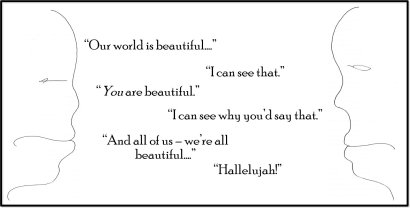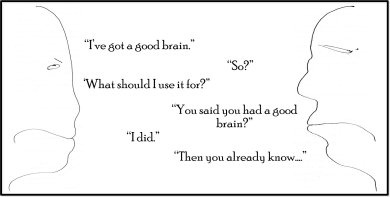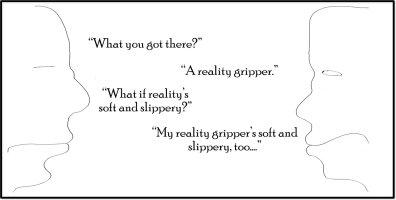1: Inside us
Evolution is developmental.
It builds on what it’s already got.
It re-uses stuff.
It tries something and if it works it puts it to use far and wide.
Photosynthesis, for example.
Or the metabolic cycle.
The human brain didn’t come out of nowhere.
Nothing comes out of nowhere.
We each of us contain the history of life on Earth.
2: Acknowledgement
“I like that image,” you say. “It’s almost mystical.”
Mystical?
I’m afraid mysticism’s not my thing.
But there’s no denying the wonder of it, the beauty, the complexity. Our brains are made of cells containing structures evolved in the first two billion years of life.1 A power of invention existed already in the primeval unicellular world before multi-celled critters came onto the scene – and it just got better from there.
We didn’t get here by ourselves.
We stand on the shoulders of the species who came before us.

3: Eyes and teeth
Consider your eyes. They’re not the first eyes. Molluscs have eyes. The Mantis shrimp has eyes it uses in a colour detection technique like the one we use in satellites.2 Insects have eyes. Amoebae have eyespots.
Your teeth are not the first teeth. Your brain is not the first brain. The building blocks of our brains existed in creatures a little like the horseshoe crab, scuttling across ocean beds over five hundred million years ago.3 There, inside your head, you’ll find a fish brain, a reptile brain, the ape brain of our common ancestor with the chimpanzee.4
Give your ape brain a typewriter and an infinity of time and it’ll write the complete works of Shakespeare… And an entire set of Mills & Boon, too.
4: Assess and decide
Level upon level, evolution assembled us.
Incrementally. Bit by bit. Driven by life’s purpose to perpetuate itself; to grow; to survive.
So what’s it achieved, this long, slow, stop-and-start, try-and-try-again process of evolving?
It’s given us a brain containing one hundred and sixty billion cells.5 It’s given us a brain within which messages travel at almost seven thousand metres per second6 – a brain sustained by six hundred and forty kilometres of capillaries, over and above the main cranial arteries and veins7.
It’s given us a brain which controls and administers, mostly without our thinking about it, our ingenious organs and limbs. It’s given us a brain which receives and records and recalls the overlapping inputs of our senses.
And then, on top of that, above and beyond our fish brains, our reptile brains and our ape brains, it’s given us the best Assess-and-Decide neural web of any other creature yet evolved.
Evolution did that for us.
Feeling grateful?

6: Reality
Because of this brain of ours we can get to grips with reality. It’s a wonderful skill – we should count ourselves lucky. We’re better at this than any other animal on Earth.
And why’s that a good thing? It’s good because the better the grip we have on reality the more we can do.
Human history proves that. The Aztecs didn’t have computers or cars. Why? Because they hadn’t yet acquired a sufficiently powerful understanding of what’s out there, of what’s achievable in the real world.
The Elizabethans didn’t have MRIs or satellites. Why?
Here’s a clue… It’s all about reality.
In the 2020s we’re unable to regrow human limbs. You’d like to know why?
It’s because we’ve yet to learn enough about reality to do that…
But we’re working on it.
As we learn more and more about our world, the possibilities are astounding.
So you’re wondering what’s the point of the human brain?
I’ll tell you.
It’s a reality-gripper.
If it’s not getting to grips with reality it’s not doing its job.

7: The point of the brain vs the point of our lives
“So that’s our point in life, is it?” you ask. “Finding out as much as we can about reality?”
Well, yes… and no.
It’s a great point – and it’s what the brain is for – but it’s not our point.
You see, we’re not just our brains.
Our point is something more than that.
Our point lies in the very heart of what we are. Our point is life’s point: the embodiment and expression of life; the fulfilment and perpetuation of life; the nurturing of life.
Life is life’s point8 – and it’s our point too.
There’s always a better way to live, a better way to survive, to thrive, to nurture one another, to nurture all the life upon our world.
That’s our point.
Finding that better way?
That’s the point of the human brain.
www.ethicalintelligence.org “The ethics of common sense”
Twitter & Facebook: @EthicalRenewal
References/Notes
- Ribosomes, chromosomes, mitochondria, DNA, RNA, cytoplasm, cell membranes.
- Yong, Ed (2014). The Mantis Shrimp Sees Like A Satellite. National Geographic. See: https://www.nationalgeographic.com/science/phenomena/2014/01/23/the-mantis-shrimp-sees-like-a-satellite/
- Tanaka, Gengo (2013). Chelicerate neural ground pattern in a Cambrian great appendage arthropod. Nature. See: https://www.nature.com/articles/nature12520
- Or, as Richard Blaber (Twitter, @RMBlaber56) notes: A.k.a. the R-complex (‘R’ for ‘reptile’), or palaeocortex; the mid-brain (mammalian brain), a.k.a. the limbic system or mesocortex; & the primatial brain, or neocortex. Also thanks to Bill Reagan (Twitter, @BillReagan16) for his correction to an earlier version of this paragraph.
- Neurones, approx. 80b; non-neurones, approx. 80b. Herculano-Houzel, Suzana (2019).Your big brain makes you human. The Conversation. See https://theconversation.com/your-big-brain-makes-you-human-count-your-neurons-when-you-count-your-blessings-127398.
- Approximate speed of messages within your brain. See Ross, Valerie (2011). Numbers: The Nervous System, From 268-MPH Signals to Trillions of Synapses. Discover Magazine: https://www.discovermagazine.com/health/numbers-the-nervous-system-from-268-mph-signals-to-trillions-of-synapses.
- Cipolla, Marilyn (2009). The Cerebral Circulation. National Center for Biotechnology InformationSee https://www.ncbi.nlm.nih.gov/books/NBK53081/.
- See A Short Conversation About The Meaning Of Life in my book Short Conversations: During the Plague (2020). Dark Green Books.
© Luke Andreski 2020. All rights reserved.
Time to read this:
Short Conversations: During the Plague
“A book which cuts to the heart of populism, climate denial, our profit-driven culture and the integrity of our politicians…”
https://www.amazon.co.uk/Short-Conversations-About-Everything-Matters/dp/B089M5BGGF

Want to penetrate the tsunami of propaganda and spin?
Try this:
Ethical Intelligence by Luke Andreski
www.amazon.co.uk/Ethical-Intelligence-Luke-Andreski/dp/179580579X
Need a fundamental basis for activism?
Try this:
Intelligent Ethics by Luke Andreski
www.amazon.co.uk/Intelligent-Ethics-Luke-Andreski/dp/1794618732